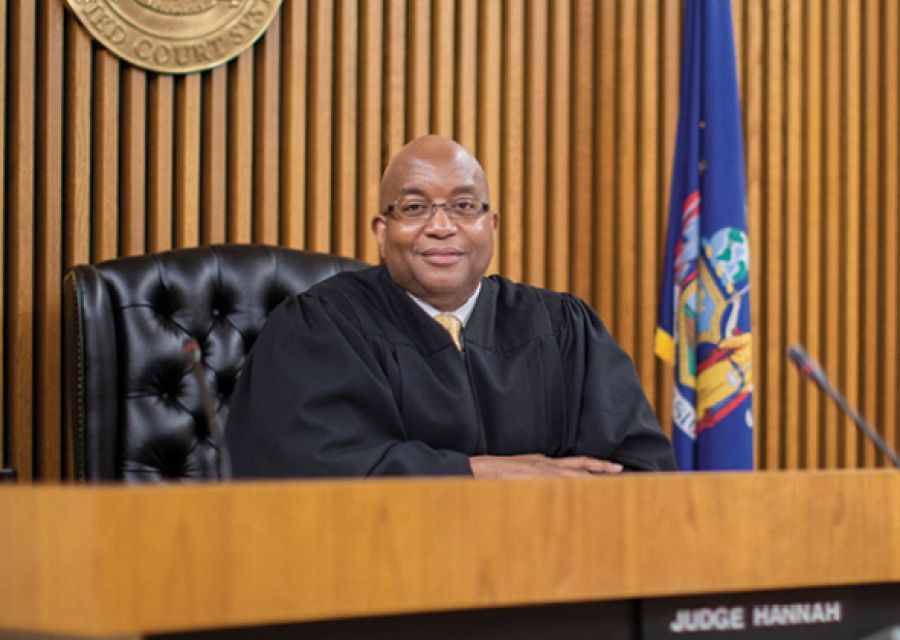
Sometimes, the best coach is a former player. Such is the case with Chief City Court Judge Craig D. Hannah ’92, who shares a similar struggle with the men and women who enter his courtroom.
Hannah is a recovering cocaine addict.
At 18 years sober, he’s also a pioneering jurist who presides over the nation’s first Opiate Crisis Intervention Court.
“There’s no shame in addiction,” Hannah says. “But it’s something I tackle every day and every day I don’t use, is another victory.”
Hannah brings that same mindset to his Buffalo courtroom, where every offender who enters is offered a deal: Complete an addiction treatment program and prosecutors may look favorably at reducing the charges.
This idea, to put rehabilitation ahead of prosecution, is in contrast to traditional drug courts, which often condemn addicted, nonviolent offenders to jail while they wait to enter a detox program or inpatient treatment center. The process can take weeks. The delay, sometimes deadly. What’s more, “you can’t lock up addiction” Hannah explains. “You need to treat the root problem if you want to stop the revolving door of people coming in and out of the criminal justice system.”
It’s for this reason that Hannah hits the pause button on an offender’s criminal charges and instead remands them to immediate treatment. Participation in his opiate court is voluntary and includes random, regular drug testing, counseling and a nightly curfew that requires participants to check in. Transitional housing is available, when necessary, and participants must appear before Hannah every day at 11 a.m. for the first 45 days; twice a week after 60 days; and once a week after 90 days. Participants who relapse aren’t punished in Hannah’s court, either. Relapsing, he believes, is part of recovery so Hannah tempers mercy with justice by requiring those who relapse to start back at day one of the treatment program.
“We take away all the road blocks and impediments to ensure treatment goes smoothly and that we keep people drug free and alive,” he says.
Hannah is living proof that life can be lived drug free.
The youngest of six children, he grew up in Buffalo’s Cold Springs neighborhood where, he says, “drugs were a way of life.” While his friends were getting arrested and going to jail, Hannah succeeded academically at City Honors High School in Buffalo and then in the political science program at Canisius. But his luck ran out after college when Hannah enlisted in the U.S. Marine Corps. On the eve of his physical, Hannah used cocaine thinking it would be his last time. He didn’t expect to get drug tested the next morning at officer training camp.
“I knew I messed up,” recalls Hannah who left before the results even came back. He realized then that he “needed to get 100 percent clean” if he was ever going to make something of himself.
And he did.
Hannah resolved to pursue a law degree, much like two Canisius predecessors he revered: LeRoi C. Johnson ’71, HON ’18 and Hon. Kevin M. Carter ’86. He graduated from the University at Buffalo School of Law in 1995 and went to work as a trial attorney in public and then private practice. In 2006, Buffalo Mayor Byron Brown appointed Hannah a Buffalo City Court Judge. A decade later, he and two other magistrates established the Opiate Crisis Intervention Court, which put Hannah on the frontlines of an epidemic that averages one overdose death each day in Erie County.
Since the program’s inception, roughly 400 people have participated. None have died of an overdose. And now, governors in eight states are modeling Hannah’s courtroom in their own jurisdictions to help treat opioid addicts at an offender’s first interaction with the criminal justice system.
Hannah couldn’t be more proud because he knows, firsthand, that the road to recovery begins with small steps.
“We have to take the stigma away from opioid addiction,” he says. “That’s why I share my story with everyone who comes into my courtroom. They’re helping me stay clean just as I’m trying to help them. The only difference between me and them – is time.”



